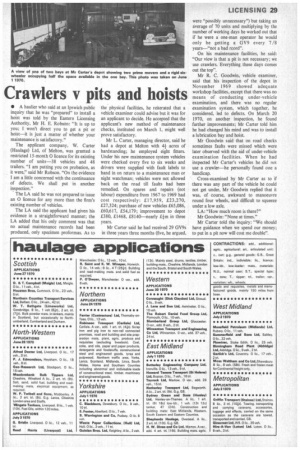Crawlers v pits and hoists
Page 31

If you've noticed an error in this article please click here to report it so we can fix it.
• A haulier who said at an Ipswich public inquiry that he was "prepared" to install a hoist was told by the Eastern Licensing Authority, Mr H. E. Robson: "It is up to you; I won't direct you to get a pit or hoist—it is just a matter of whether your maintenance is satisfactory."
The applicant company, W. Carter (Haulage) Ltd, of Melton, was granted a restricted 15-month 0 licence for its existing number of units-38 vehicles and 48 trailers. "I am putting you on probation, as it were," said Mr Robson. "On the evidence I am a little concerned with the continuance of defects. We shall put in another inspection."
The LA said he was not prepared to issue an 0 licence for any more than the firm's existing number of vehicles.
The LA said the applicant had given his evidence in a straightforward manner; the LA added that his only comment was that no actual maintenance records had been produced, only specimen proformas. As to the physical facilities, he reiterated that a vehicle examiner could advise but it was for an applicant to decide. He accepted that the applicant's new method of maintenance checks, instituted on March 1, might well prove satisfactory.
Mr L. Carter, managing director, said he had a depot at Melton with 44 acres of hardstanding; he employed eight fitters. Under his new maintenance system vehicles were checked every five to six weeks and drivers were supplied with fault labels to hand in on return to a maintenance man or night watchman; vehicles were not allowed back on the road till faults had been remedied. On spares and repairs (not labour) expenditure from 1967 to 1969 had cost respectively: £17,959, £23,270, £27,324; purchase of new vehicles £65,086, £60,617, £54,179; improvement to depot £380, £1468, .£8140—nearly £fm in three years.
Mr Carter said he had received 29 GV9s in three years three months (five, he argued, were "possibly unnecessary") but taking an average of 70 units and multiplying by the number of working days he worked out that if he were a one-man operator he would only be getting a 0V9 every '7/8 year s—"not a bad rcord".
On his maintenance facilities, he said: "Our view is that a pit is not necessary; we • use crawlers. Everything these days comes out the top".
Mr R. C. Goodwin, vehicle examiner, said that his inspection of the depot in November 1969 showed adequate workshop facilities, except that there was no means of conducting under-vehicle examination, and there was no regular examination system, which together, he considered, led to defects. On March 20 1970, on another inspection, he found further improvements; Mr Carter told him he had changed his mind and was to install a lubrication bay and hoist.
Mr Goodwin said that on road checks sometimes faults were missed which were later observed with the aid of under-vehicle examination facilities. When he had inspected Mr Carter's vehicles he did not use a crawler—he personally found one a handicap.
Cross-examined by Mr Carter as to if there was any part of the vehicle he could not get under, Mr Goodwin replied that it was, of course, awkward to manoeuvre round four wheels, and difficult to squeeze under a low axle.
LA: "How much room is there?"
Mr Goodwin: "None at times."
Mr Carter told the inquiry: "We should have guidance when we spend our money; to put in a pit now will cost me double".












































































































